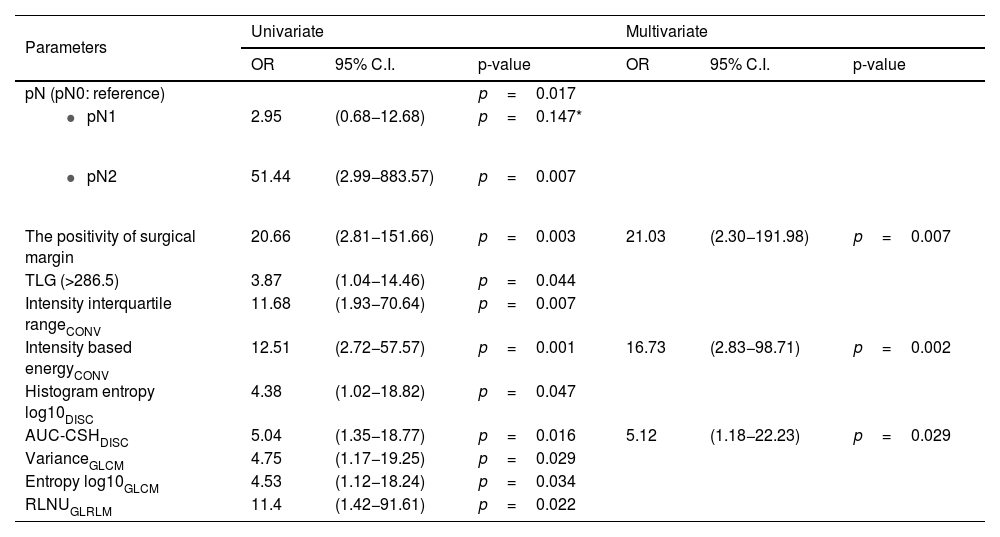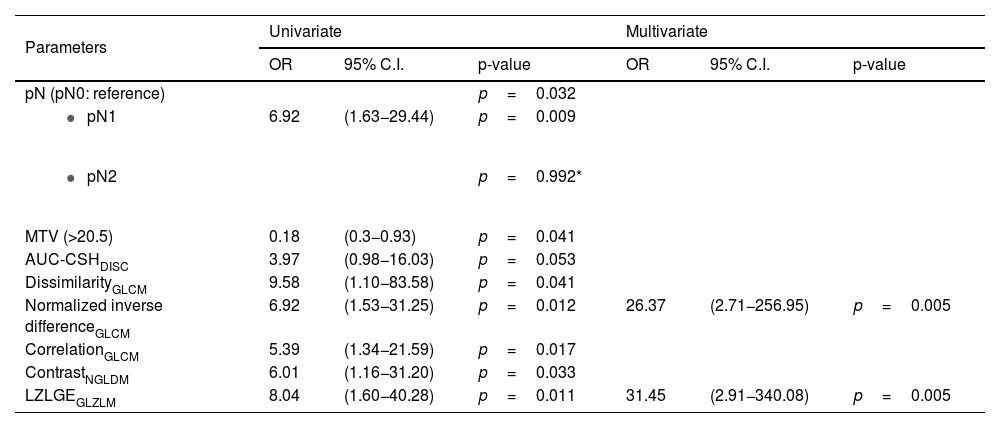This retrospective study aimed to investigate the value of texture features of primary tumors in pretreatment 18F-FDG PET/CT in the prediction of response to treatment, progression, and overall survival in patients with rectal cancer who underwent surgery after neoadjuvant therapy(NAT).
MethodsPatients with rectal cancer who had pretreatment 18F-FDG PET/CT, and underwent surgery after NAT were included in this study. Clinicopathologic features, date of last follow-up, progression, and death were recorded. Textural and conventional PET parameters(maximum standardized uptake value-SUVmax, metabolic tumor volume-MTV, total lesion glycolysis-TLG) were obtained from PET/CT images using LifeX program. Parameters were grouped using Youden index in ROC analysis. Factors predicting the pathological response to treatment, progression, and overall survival were determined using logistic regression and Cox regression analyses.
ResultsForty-four patients (26(59%) male, 18(41%) female; 60.1±11.4 years) with rectal cancer were included in this study. The numbers of patients with responders and non-responders to NAT were 15(34.9%) and 28(65.1%), respectively. One patient’ pathology report did not contain the response status to NAT. The median of follow-up duration was 29.9 months. 9(20.5%) showed disease progression, and 8(18.2%) died during the follow-up period. Difference entropyGLCM and correlationGLCM parameters were found as independent predictors for response to NAT. The positivity of surgical margin, intensity interquartile rangeCONV and AUC-CSHDISC texture parameters were independent predictors of progression, while normalized inverse differenceGLCM and LZLGEGLZLM parameters were independent predictors of mortality.
ConclusionThe texture parameters obtained from pretreatment 18F-FDG PET/CT have presented a more robust predictive value than conventional parameters in patients with rectal cancer who underwent surgery after NAT.
Estudio retrospectivo cuyo objetivo fue investigar el valor de las características de textura de los tumores primarios en la PET/TC con 18F-FDG pretratamiento para la predicción de la respuesta al tratamiento, la progresión y la supervivencia gobal en pacientes con cáncer de recto que se sometieron a cirugía después de la terapia neoadyuvante (TNA).
MétodosSe incluyeron en este estudio pacientes con cáncer de recto que se sometieron a estudio PET/TC con 18F-FDG antes del tratamiento y se sometieron a cirugía después de TNA. Se registraron las características clínico-patológicas, la fecha del último seguimiento, la evolución y fallecimiento Los parámetros de las texturas y los convencionales de PET (Standard Uptake Value-SUVmax, volumen tumoral metabólico-MTV, glucólisis total de la lesión-TLG) se obtuvieron a partir de imágenes PET/TC utilizando el programa LifeX. Los parámetros se agruparon utilizando el índice de Youden en el análisis ROC. Los factores que predicen la respuesta patológica al tratamiento, la progresión y la supervivencia global se determinaron mediante regresión logística y análisis de regresión de Cox.
ResultadosCuarenta y cuatro pacientes (26-59% hombres, 18-41% mujeres; 60,1±11,4 años) con cáncer de recto fueron incluidos en este estudio. El número de pacientes respondedores y no respondedores a TNA fueron de 15 (34,9%) y 28 (65,1%), respectivamente. La mediana de la duración del seguimiento fue de 29,9 meses. 9 (20,5%) mostraron progresión de la enfermedad y 8 (18,2%) fallecieron durante el período de seguimiento. Los parámetros de entropía GLCM de diferencia y correlación GLCM se encontraron como predictores independientes para la respuesta a TNA Los parámetros de positividad del margen quirúrgico, rango intercuartílico de intensidad CONV y textura AUC-CSHDISC fueron predictores independientes de progresión, mientras que los parámetros de diferencia inversa normalizada GLCM y LZLGEGLZLM fueron predictores independientes de mortalidad.
ConclusiónLos parámetros de textura obtenidos de la PET/TC con 18F-FDG pretratamiento han presentado un valor predictivo más robusto que los parámetros convencionales de la PET en pacientes con cáncer de recto que se sometieron a cirugía después de TNA.
Article

Revista Española de Medicina Nuclear e Imagen Molecular (English Edition)











